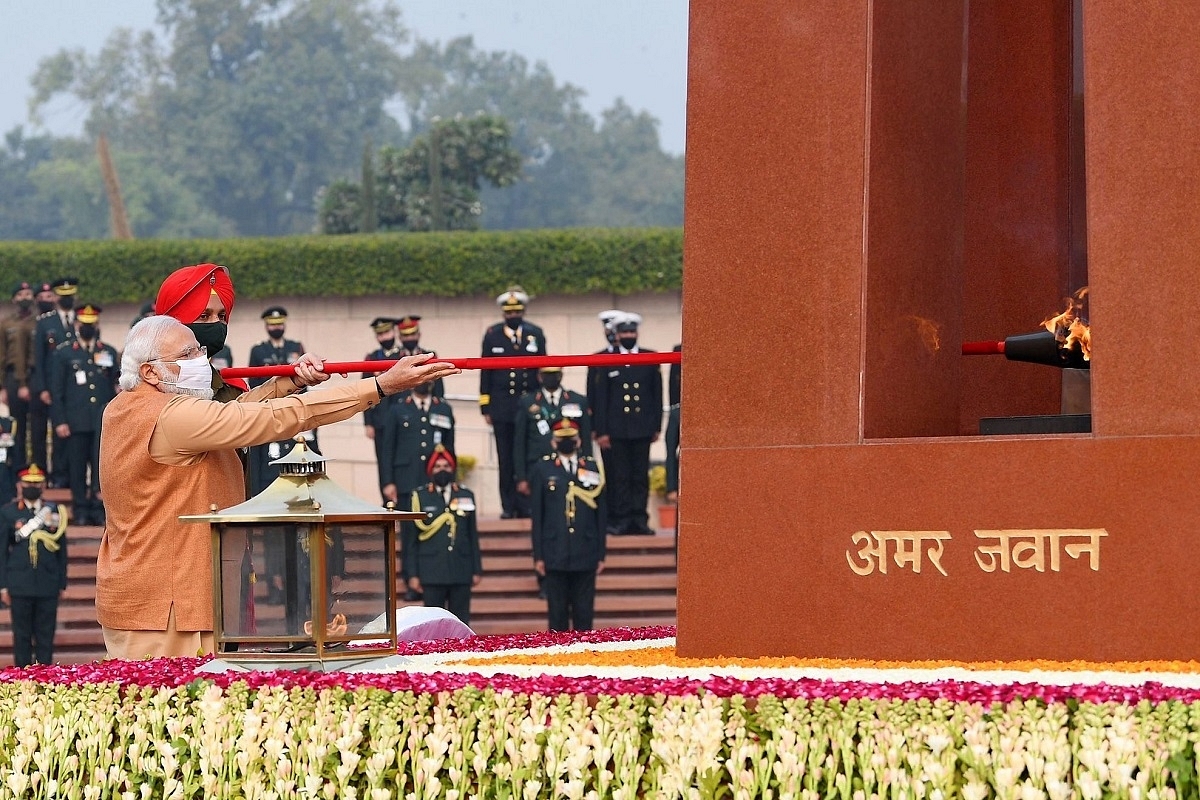News Brief
Amar Jawan Jyoti: Separating Fact From Fiction
- The Amar Jawan Jyoti at the India Gate is not being extinguished; it is being merged with the eternal flame at Amar Chakra of the National War Memorial.

Prime Minister Narendra Modi lighting the flame at the National War Memorial.
Earlier today (21 January), the Union government announced that the Amar Jawan Jyoti, also called the 'Flame of the immortal soldier', will be merged with the immortal flame at the National War Memorial inaugurated in 2019. Along with this, a granite statue of Netaji Subhash Chandra Bose will be installed at India Gate, where King George V's statue stood until 1968.
While many, including veterans, have welcomed the move, the two announcements made by the Narendra Modi government have caused a political furore, with the Congress, which sees the Amar Jawan Jyoti at India Gate as a legacy of former prime minister Indira Gandhi, leading the opposition on the issue. The eternal flame complex at the India Gate was built by the Indira Gandhi government after the 1971 war.
Is The Amar Jawan Jyoti Being Extinguished?
In a tweet after the news made headlines, former Congress president Rahul Gandhi said that the eternal flame at the India Gate is being extinguished. The same claim was reposted by multiple other Congress leaders and Twitter handles, and repeated by leaders from other political parties, including the Shiv Sena, which has increasingly aligned itself with the Congress. The claim, however, is wrong. As stated earlier, the Amar Jawan Jyoti at the India Gate is not being extinguished; it is being merged with the eternal Flame at Amar Chakra of the National War Memorial.
Later today, Air Marshal Balabadra Radha Krishna, who is serving as the Chief of Integrated Defence Staff in the absence of serving Chief of Defence Staff after the death of General Bipin Rawat, will merge the flames of Amar Jawan Jyoti with the eternal flame at the National War Memorial. The ceremony will take place today starting 3.30 pm. The eternal flame will be moved to the National War Memorial in a torch along with Guard Contingent, and the two flames will be merged.
Is the removal of the Amar Jawan Jyoti complex from India Gate a disrespect to India's War heroes?
Most veterans, including multiple former chiefs of the three armed services of the Indian military, have welcomed the decision.
"A natural thing to do now that the National War Memorial has been established and all ceremonials related to remembrance and honouring soldiers killed in action are being held there," General Ved Prakash Malik, the army chief during the Kargil War, has said.
"I don't want to get into the politics, but with all ceremonies now happening at the National War Memorial, it's appropriate that the flames be merged. Not to devalue iconic India Gate, but now with the NWM, appropriate that the Amar Jawan Jyoti be there," Lieutenant General Deependra Singh Hooda, who helmed the 2016 surgical strikes and headed a task force on national security set up by Rahul Gandhi ahead of the 2019 General Election, says.
Located under the India Gate at Rajpath, the Amar Jawan Jyoti was built in December 1971 and unveiled by Indira Gandhi on 26 January 1972 to commemorate India's victory in India-Pakistan War 1971. The eternal flame has been burning since. The 42-metre-high arch under which it stands was built by the British in 1931 in the memory of soldiers of the British Indian Army who died between 1914 and 1921 in the First World War and the Third Afghan War fighting for the Empire and is viewed as a symbol of India's colonial past. The statue of King George V, which stood not very far from where the Amar Jawan Jyoti was built, was removed only in 1968.
Out of over 83,000 Indian soldiers who had died during the various military campaigns of the British Empire, India Gate bears the names of just 13,516, the website of the National War Memorial says.
The National War Memorial, in comparison, was built in commemoration of the sacrifices made by Indian soldiers since Independence. Spread over 40 acres, the memorial has the names of 25,942 Indian soldiers who have died fighting in conflicts after 1947, including the 1971 War.
The memorial, promised to the armed forces for the first time in the 1960s, was approved by the Narendra Modi government in 2015.
Many veterans have argued that the delay in building an all-encompassing national war memorial by successive governments was disrespectful to the armed forces, not the merging of the eternal flames.
Introducing ElectionsHQ + 50 Ground Reports Project
The 2024 elections might seem easy to guess, but there are some important questions that shouldn't be missed.
Do freebies still sway voters? Do people prioritise infrastructure when voting? How will Punjab vote?
The answers to these questions provide great insights into where we, as a country, are headed in the years to come.
Swarajya is starting a project with an aim to do 50 solid ground stories and a smart commentary service on WhatsApp, a one-of-a-kind. We'd love your support during this election season.
Click below to contribute.
Latest